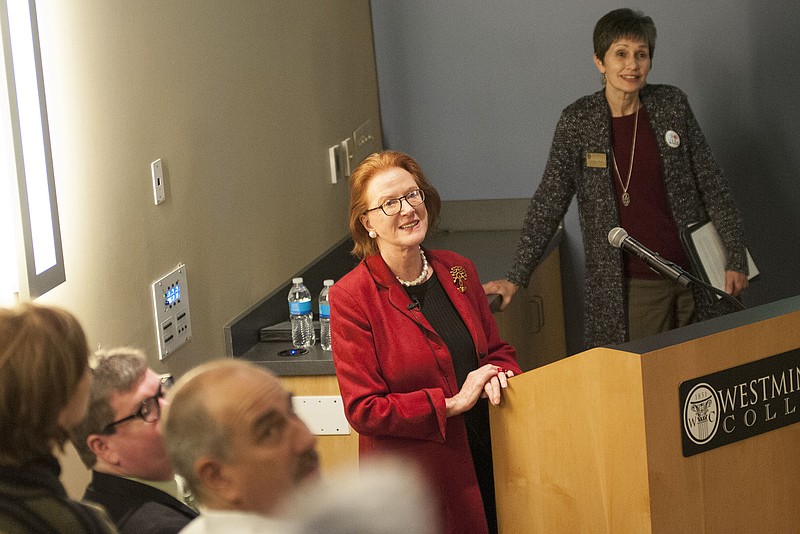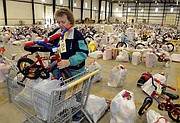Edwina Sandys, granddaughter of Winston Churchill, said the news on Nov. 9, 1989 that the Berlin Wall was coming down was welcome surprise.
"It happened very, very suddenly. People were amazed when it did happen. It was a hopeful thing, a joyful moment." Sandys said during a presentation Sunday at Westminster College. "It was the withering and dwindling of Soviet power, which finally fell off like a dried twig off a branch. The world was amazed and joyful."
On the 25th anniversary of the fall of the Berlin Wall, Sandys shared the story of how she traveled to Berlin in the months following that historic day to claim the eight sections of the wall that eventually became the "Breakthrough" sculpture on the Westminster campus.
Sandys said she first heard from friends that visitors were traveling to Berlin and bringing home small pieces of the wall with them - news which inspired her to try for something a bit bigger.
She said she decided she wanted to make a sculpture linking her grandfather's famous Sinews of Peace speech - better known as the Iron Curtain speech, which he gave at Westminster in 1946 - with the tearing down of what had become the "physical embodiment of the words of my grandfather" and the symbolic end of the Cold War he had warned about during his visit to Fulton decades earlier.
Sandys said she called John Harvey Saunders, who was the president of Westminster College at the time, with a proposal.
"I said to him, "If I can get a piece of the Berlin Wall - and I have no idea how to do it - and make a sculpture out of it, would you like to have it in Fulton where the Iron Curtain speech was made?'" Sandys recalled. "He said it was a wonderful idea.
So Sandys and her husband, Richard Kaplan, travelled to Berlin with the goal of meeting with East German officials and convincing them to donate the sections of the wall - which were selling for $60,000 a piece at the time.
Through connections of friends, Sandys made contact with Dr. Keller, the minister of culture in East Berlin, whom she said was already familiar with the Iron Curtain speech and Fulton and was eager to help.
"After so many years of the Cold War, it was a strange feeling to sit down and work on a joint project with the very people I had grown up to regard as the enemy," Sandys said. "But they were human, they were friendly, they were enthusiastic, (and) they loved the idea of a monument of the Berlin Wall coming to Fulton."
Sandys also touched on how she came to select the eight pieces she brought back to New York to create that monument.
"One of the reasons I chose them was because they had "unwahr' (spray painted on them), which means untruth," she said, noting she also selected those particular sections because they were "not too busy."
She made mention of several people who helped with making the arrangements to bring the sections of the wall from Berlin to the United States and to eventually bring the finished sculpture to Fulton - including Richard Mahoney and Westminster College's Jack Marshall, whom she said "was a star in every way."
Sandys noted that prior to "Breakthrough" she had worked with more-traditional, "noble" materials such as marble and bronze and was at first unsure what to make of dealing with 32 feet of concrete sections of wall.
"But then I thought, what more noble material can there be than these ungainly slabs, steeped as they are in heroism and history," Sandys said. "On the colorful, west side of the Berlin Wall, all of the hopes and fears were expressed in graffiti and images. On the gray east side, no one could get near it ... and all their dreams go unrecorded.
Sandys said Churchill's message regarding the "Iron Curtain" was constantly on her mind while she worked on the sculpture.
"I wanted to portray freedom, breaking through the Iron Curtain, breaking through the wall," she said. "I decided to make the spaces (in the wall) in the shape of man and woman because there was a whole groundswell of people for many many years that created the situation is East Berlin that led to the possibility of the wall coming down."
Sandys made note several times that ever since the sculpture's debut - first in New York City and then in Fulton - people have always liked going through those spaces, "going from the drab, communist side and then jumping through to glorious technicolor. Everybody really liked that interaction."
"My idea is, apart from the history of it, you can go through it and imagine that what happened in Berlin and how we are fortunate that is no longer," she said. "At the same time you can use it as a sort of device for yourself. I like to feel that anybody can go in one side and get through it and say, "I'm making my own personal breakthrough.' ... I like to do that."


